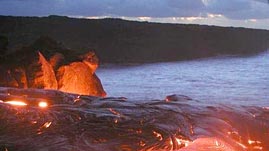Beneath Earth's surface, volcanic gases trapped under tremendous pressure are dissolved within molten rock called magma. As magma rises, the trapped gases begin to form bubbles that increase in number and size nearer the surface. If the outward pressure of the expanding gas bubbles exceeds the strength of the magma, an explosive eruption may follow, in which the magma shatters into pieces of volcanic rock that get ejected at high velocity. If the pressure is not great enough to shatter the magma, it will be expelled from the volcano as a lava flow.
Although eruptions may be classified according to the opening through which material flows or is ejected (e.g., fissure eruptions and central eruptions), by the location where volcanic material reaches the surface (e.g., summit or flank), or by their resemblance to historical eruptions (e.g., Strombolian or Vesuvian), they are most commonly classified by how powerfully they discharge magma, gases, and other debris.
Generally speaking, the most explosive eruptions come from magmas that, due to their high silica content, maintain high gas levels as they reach the surface. Silica-rich magmas, like andesite (60% silica) and dacite (70% silica), are also more viscous. The more viscous a substance is, the more it resists flow. Because these magmas do not flow quickly, pressure builds behind them as they move through vents in the volcano. By contrast, magmas that are low in silica, like basalt (about 50% silica), tend to be very fluid. They allow gas to easily escape and produce streaming lava flows and less volatile eruptions.
Although lava flows may also accompany explosive eruptions, the more commonly associated threats are tephra (ejected rock fragments), pyroclastic flows (hot flowing rock and gas mixtures), and lahars (mudflows). These can produce a variety of secondary effects that include blow-downs (when the blast from an explosion flattens trees and buildings), tsunamis (triggered in this case by landslides), and climate change (volcanic particles in the air are associated with some degree of global cooling).
Since 1700 A.D., volcanic eruptions have killed more than a quarter-million people and devastated entire communities. According to some estimates, the population at risk from volcanoes in the year 2000 stood at 500 million or more, a figure certain to grow. This makes it all the more important that scientists develop their capacity to make reliable and timely warnings of eruptions.

 Teachers' Domain is proud to be a Pathways portal to the National Science Digital Library.
Teachers' Domain is proud to be a Pathways portal to the National Science Digital Library.
